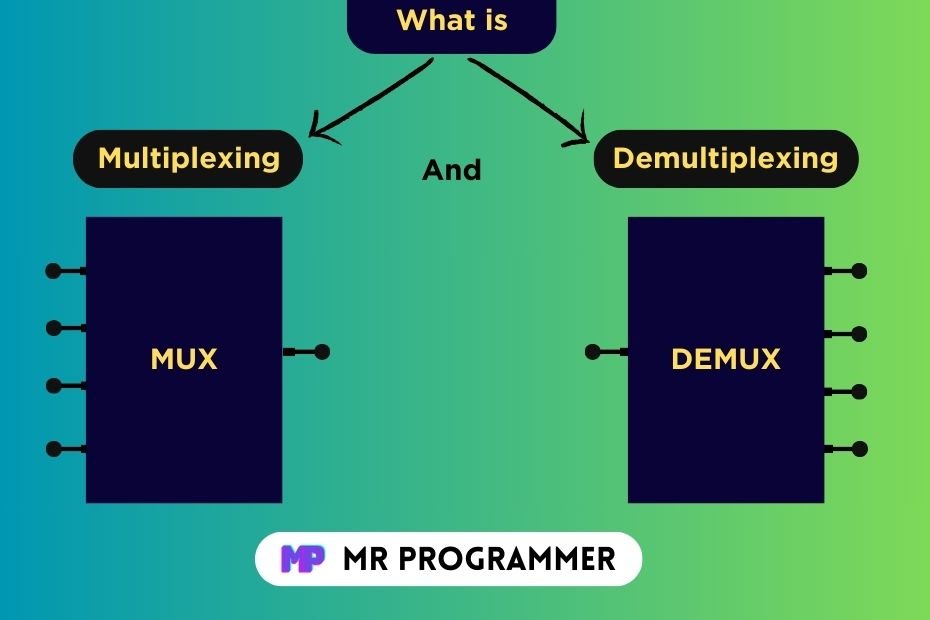Multiplexing and Demultiplexing are the processes involved during data transmission in computer networking. In this blog post, you will learn how these two work and what are these two processes in simple terms.
Table of Contents
What is Data Transmission?
Data transmission refers to the transmission of digital data from one location to another. It involves encoding data into electrical signals, light pulses, or radio waves, these signals are transmitted through a communication medium such as cables, optical fibers, or airwaves, and then decoding the signals at the receiving end to rebuild the original data. The main components in data transmission include the transmitter (which initiates the transmission), the communication channel (the medium through which the data travels), and the receiver (which captures and decodes the transmitted data). Various protocols and technologies, such as modulation techniques, error detection and correction mechanisms, and data compression algorithms, are used to ensure efficient and reliable transmission.
Also Read: How to Check Python Version In Windows, Mac, And Linux – Complete Guide
Challenges Faced During Transmitting Multiple Data Streams
There are several challenges faced when transmitting multiple data streams:
- Bandwidth Management: Each data stream requires its portion of the available bandwidth. Ensuring that there is enough bandwidth for all streams without causing congestion or bottlenecks can be challenging, especially in networks with limited capacity.
- Interference: When multiple streams share the same communication medium, interference can occur. This interference may arise due to overlapping frequencies or conflicting signal timings, leading to bad signal quality and potential data loss.
- Synchronization: Maintaining synchronization among multiple data streams is important for proper data reception. Any disparity in timing or phase alignment between streams can result in data corruption and difficulties in accurately reconstructing the transmitted information.
- Resource Allocation: Efficiently allocating resources such as bandwidth transmission power, and the buffer space among multiple streams is essential for optimizing overall system performance. Dynamic resource allocation strategies are often necessary to adapt to changing network conditions and varying data traffic demands.
- Multiplexing Techniques: Various multiplexing techniques, such as time-division multiplexing (TDM), frequency-division multiplexing (FDM), and code-division multiplexing (CDM), are used to enable the transmission of multiple streams over a shared communication channel. Implementing these techniques effectively requires a careful coordination channel. Implementing these techniques effectively requires careful coordination and management of the multiplexed signals.
- Crosstalk: In wired communication systems, crosstalk can occur when signals from one data stream leak into its beside channels, leading to interference and signal distortion. Proper shielding and signal isolation techniques are necessary to mitigate crosstalk effects.
How Multiplexing and Demultiplexing Techniques Used?
Multiplexing and demultiplexing are techniques used in data communication to smoothly transmit multiple data streams over a single communication channel.
- Multiplexing: Multiplexing is the process of combining multiple data streams into a single combined signal for transmission over a shared medium. This technique optimizes the utilization of available bandwidth and resources. There are various types of multiplexing:
- Time-Division Multiplexing (TDM): In TDM, each data stream is allocated a fixed time slot within a predefined time frame. The data from each stream is transmitted sequentially during its allocated time slot. TDM is commonly used in applications such as digital telephone systems.
- Frequency-Division Multiplexing (FDM): FDM assigns a unique frequency band to each data stream within the available range. The data streams are then modulated onto carrier signals at different frequencies and transmitted simultaneously over the communication channel. FDM is often used in radio and television broadcasting.
- Code-Division Multiplexing (CDM): Each data stream is assigned a unique code by CDM, so multiple streams can be sent at the same time over a single frequency band. The coded signals are then combined and transmitted, and the receiver uses the appropriate decoding algorithm to extract the original data streams. CDM is commonly employed in spread-range communication systems.
2. Demultiplexing: Demultiplexing is the reverse process of multiplexing, where a combined signal containing multiple data streams is separated into individual streams at the receiving end. Demultiplexing is necessary to extract and deliver each data stream to its intended destination. Depending on the multiplexing technique used, demultiplexing includes:
- Time-Division Demultiplexing: The receiver identifies and extracts each data stream based on its assigned time slot within the received signal frame.
- Frequency-Division Demultiplexing: The receiver filters the combined signal to separate the frequency bands corresponding to each data stream, then demodulates and processes each stream separately.
- Code-Division Demultiplexing: The receiver uses the appropriate decoding algorithm to separate and recover each data stream on the unique code assigned to it during multiplexing.
What is Multiplexing?
Multiplexing is a technique used in telecommunication and data transmission to combine multiple data streams into a single signal for efficient transmission over a shared medium. Its core objective is to optimize the use of available bandwidth and resources, enabling the continuous transmission of multiple signals without causing interference or congestion.
How Multiplexing Combines Multiple Data Streams Into a Combined Signal
Multiplexing achieves its main objective by interleaving or combining multiple data streams into a combined signal, and then transmitted over a communication channel. This process involves allocating specific resources such as time slots, frequency bands, or codes to each data stream, allowing them to share the transmission medium effectively.
Also Read: What is ATM in Computer Network? | Is ATM in Computer Network Still Used?
Types Of Multiplexing
There are mainly two types of multiplexing:
- Connection-Oriented Multiplexing: In connection-oriented multiplexing, a dedicated logical connection is established between the sender and receiver before data transmission begins. This connection typically involves negotiation and setup procedures to allocate resources and establish communication parameters. Examples of connection-oriented multiplexing include Time-Division Multiplexing (TDM) and Frequency-Division Multiplexing (FDM).
- Connectionless Multiplexing: Connectionless multiplexing does not require a predefined connection setup between the sender and receiver. Data packets are transmitted independently and are routed based on addressing information contained within each packet. Code-Division Multiplexing (CDM) is an example of connectionless multiplexing, where each data stream is encoded with a unique code and transmitted concurrently over the same frequency band.
Benefits of Multiplexing
There are several advantages to multiplexing, including:
- Optimized Bandwidth Utilization: Multiplexing allows for the grouping of multiple data streams onto a single communication channel, maximizing the utilization of available bandwidth. This efficient use of bandwidth ensures that network resources are used effectively, minimizing wasted capacity and improving overall network performance.
- Scalability: Multiplexing enables easy scalability of communication networks. As the demand for communication services evolves, additional data streams can be multiplexed onto existing channels without the need for significant infrastructure upgrades. The scalability ensures that communication networks can accommodate increasing traffic demands while maintaining performance and reliability.
- Flexibility: Multiplexing provides flexibility in managing communication resources. Different multiplexing techniques can be employed based on the specific requirements of the application and the characteristics of the data being transmitted. The flexibility allows customization of communication systems to meet various needs, whether it involves prioritizing certain data streams, adapting to varying traffic, patterns, or supporting different types of services.
- Improved Reliability: Multiplexing can enhance the reliability of communication systems by providing redundancy and fault tolerance. In some multiplexing types, such as Time-Division Multiplexing (TDM) and Frequency-Division Multiplexing (FDM), data streams are segmented into separate units or allocated separate frequency bands. This segmentation helps the separation of individual data streams, reducing the impact of failures or disruptions on the overall system.
- Enhanced Data Security: Multiplexing can contribute to data security by separating different data streams and preventing unauthorized access or interception. By multiplexing data onto shared communication channels in a controlled manner, communication networks can implement encryption, access control, and other security measures to safeguard sensitive information from unauthorized access or tampering.
How Does Multiplexing Work?
Here is how multiplexing works with the concepts of a multiplexer (MUX).
What is a Multiplexer (MUX)
Think of a multiplexer (MUX) as a digital switchboard or a traffic controller for data streams. It is a device that takes multiple input data streams and combines them into a single output stream for transmission over a shared communication channel.
Role of a MUX in Combining Data Streams
Imagine you have a group of friends who you want to send you messages simultaneously. Each friend has their own message to send, and they all want to use the same communication channel to reach you. However, since only one message can be sent at a time, you need a way to combine all these messages into a single stream before they can be transmitted to you.
This is where the role of the multiplexer comes in. The multiplexer collects all the incoming messages from your friends and organizes them into a single stream, ensuring that each message is transmitted in its turn. It does this by assigning a specific time slot (in Time-Division Multiplexing) or frequency band (in Frequency-Division Multiplexing) to each incoming message.
Once all the messages are combined into a single stream by the multiplexer, they can be transmitted over the communication device called a demultiplexer (DEMUX), which is used to separate the combined stream back into its individual components, allowing you to receive and process each message separately.
What is Demultiplexing?
Demultiplexing is the reverse process of multiplexing. It involves separating a combined data stream, which contains multiple data streams multiplexed together, back into their individual components or original data streams. Demultiplexing is closely related to multiplexing and is essential for retrieving the individual data streams after transmission.
How Demultiplexing is Related to Multiplexing
Demultiplexing components multiplexing by reversing the process of combining multiple data streams into a single stream for transmission. While multiplexing consolidates several data streams into one, demultiplexing disassembles the combined stream to recover the original data streams at the receiving end.
Separating the Combined Data Stream
Demultiplexing separates the combined data stream based on the criteria used during multiplexing. For example:
- In Time-Division Multiplexing (TDM), demultiplexing uses timing information to identify and extract each individual data stream from its decided time slot within the combined stream.
- In Frequency-Division Multiplexing (FDM), demultiplexing employs frequency filtering to separate each data stream based on its assigned frequency band within the combined stream.
- In Code-Division Multiplexing (CDM), demultiplexing uses decoding algorithms to recover each data stream based on the unique code assigned during multiplexing.
Role of a Demultiplexer (DEMUX) at the Receiving End
At the receiving end, a demultiplexer (DEMUX) is used to perform the demultiplexing process. The demultiplexer identifies and separates the combined data stream back into its individual components or original data streams. Each recovered data stream is then directed to its respective destination or processing unit for further analysis, storage, or distribution.
Demultiplexing is an important process for ensuring the delivery of the transmitted data streams to their recipients and processed appropriately. It enables efficient utilization of communication channels by allowing multiple data streams to share the same transmission medium while maintaining data integrity and individual stream separation.
Use Cases Of Multiplexing and Demultiplexing
Multiplexing and demultiplexing find wide applications across various communication networks and systems, facilitating efficient data transmission and reception. Here are some real-world examples:
- Internet Communication Networks:
- In Internet communication networks, multiplexing techniques like Time-Division Multiplexing (TDM) and Frequency-Division Multiplexing (FDM) are employed to collect multiple data streams onto shared transmission lines.
- For example, in digital subscriber line (DSL) technology, FDM is used to divide the available bandwidth into separate frequency channels, allowing simultaneous transmission of voice and data over a single telephone line.
- Demultiplexing is then performed at the receiving end to separate and extract the individual data streams for processing by the respective applications or devices.
2. Cable Television (CATV) Systems:
- CATV systems use multiplexing to combine multiple television channels and other multimedia content onto a single coaxial cable for distribution to subscribers.
- Frequency-division multiplexing (FDM) is commonly employed, with each TV channel allocated a specific frequency band within the cable range.
- At the subscriber’s end, a cable set-top box or tuner performs demultiplexing to extract the desired channels from the combined cable signal, allowing viewers to watch different channels at once.
3. Telephone Systems:
- Telephone systems use multiplexing to enable multiple voice conversations to be transmitted over a single physical connection.
- Time-division multiplexing (TDM) is widely used in traditional circuit-switched telephone networks, where each phone call is allocated a dedicated time slot for transmission over the communication channel.
- At the receiving end, demultiplexing separates the incoming time-division multiplexed signal into individual voice channels, allowing each call to be routed to the correct recipient.
4. Wireless Communication Systems:
- Wireless communication systems use multiplexing techniques such as Code-Division Access (CDMA) to enable multiple users to share the same frequency band.
- In CDMA, each user is assigned a unique spreading code, allowing multiple users to transmit simultaneously over the same frequency band without causing interference.
- Demultiplexing is also used by the receiver using matched filtering and decoding algorithms to separate the individual user signals from the combined CDMA signal.
Conclusion
In conclusion, multiplexing and demultiplexing are the basic techniques that support modern communication systems, allowing the transmission and reception of multiple data streams over shared communication channels. These technologies play a vital role in maximizing the utilization of communication resources, optimizing bandwidth usage, and supporting the simultaneous transmission of various data types and services.
Importance of Multiplexing and Demultiplexing
Multiplexing and Demultiplexing are important for various applications, including Internet communication networks, telephone systems, cable television distribution, and wireless communication systems. By enabling the collection and separation of data streams, multiplexing and demultiplexing ensure efficient and reliable communication, supporting the growing demand for high-speed data transmission and multimedia services.
Future Advancements in These Technologies
When talking about future advancements in multiplexing and demultiplexing technologies are expected to focus on enhancing efficiency, scalability, and flexibility in communication systems. This may involve developments in advanced multiplexing techniques such as dynamic spectrum allocation, and adaptive modulation schemes. and software-defined networking (SDN) approaches. Additionally, advancements in signal processing algorithms and hardware implementations are likely to contribute to improved performance and reliability in multiplexing and demultiplexing operations.
- Introduction to Entrepreneurship: Everything You Need to Know Before You Start - June 12, 2025
- What Sets Artificial Intelligence Apart from Humans? - April 18, 2025
- Python Programming: A Comprehensive Guide for Beginners - March 27, 2025








